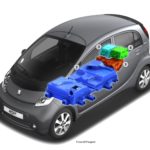One of the weak links of a regular combustion engine car is the battery. These days we all want more electronic equipment. Whether that’s sat navs, charging mobile phones or running tablets to keep the kids entertained. The trouble is all these draw current from the car’s battery and can potentially shorten battery life.
Do electronic devices drain the battery
Yes, any electronic device you plug into a car will be a drain on the vehicle’s 12-volt battery. And according to Kwik Fit, three in five of us charge mobile devices by plugging them into our cars.
Should we worry about charging devices?
It depends on the kind of mileage you do and the devices you’re charging. But charging a mobile phone or running a sat nav draws a relatively tiny amount of current. The amount the battery needs to start the car is much greater.
But if a car has a healthy battery and you do longer journeys (more than about 12 miles), every now and again, you should be fine charging mobile devices.
If you do shorter journeys and your battery is getting on a bit (they’re typically guaranteed for three or five years), be warned. Your car’s battery probably won’t be overly happy with charging a handful of devices if the battery is getting older.
Kwik Fit seems to think that charging devices cuts battery life short. We think it’ll only diminish battery life if you’re charging multiple devices, doing a limited mileage and your battery is coming to the end of its life.
What else does the battery do?
Think about this for a moment. When you plug your mobile phone, tablet or sat nav into a car, where does the power come from? It comes from the same 12v battery as the one that runs the headlights, windscreen wipers and even helps to start the car by powering the starter motor.

Where does the car’s battery get its power?
When you drain a battery, you need to recharge it or it’ll go flat and cease to operate. A car is constantly draining its battery. But when the engine is running the engine operates a component called the alternator which acts like a generator and recharges the battery.
But the alternator needs a few miles of motoring to work its magic. That’s why if you do lots of very short journeys, the battery never gets fully charged.
Think of a battery like a bank account. If you’re plugging lots of devices into it but not charging it properly, you’re withdrawing more money than you’re earning. Unlike the bank analogy, where you can get an overdraft or take out a loan, when the car’s battery goes into the red, it simply stops working.
Should you be worried?
As we’ve said, it really does depend on the kind of mileage you do, the number of devices you want to charge and the age of your car’s battery. If you’re in any doubt, get your battery tested. Most garages will do so for free. And remember: checking the battery is NOT part of the MOT test.

I’ve been writing about cars and motoring for more than 25 years. My career started on a long-departed classic car weekly magazine called AutoClassic. I’ve since pitched up at Autosport, Auto Express, the News of the World, Sunday Times and most recently the Daily Telegraph. When I’m not writing about cars and motoring, I’m probably doing some kind of sport or working in my garden.







